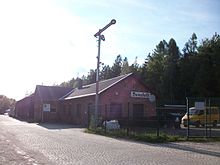Beierfeld
|
Beierfeld
City of Grünhain-Beierfeld
Coordinates: 50 ° 33 ′ 40 ″ N , 12 ° 47 ′ 14 ″ E
|
||
|---|---|---|
| Height : | 524 m | |
| Area : | 8.82 km² | |
| Residents : | 3365 (May 9, 2011) | |
| Population density : | 382 inhabitants / km² | |
| Incorporation : | January 1, 2005 | |
| Postal code : | 08344 | |
| Area code : | 03774 | |
|
Location of Beierfeld in Saxony |
||
Beierfeld is a district of the city of Grünhain-Beierfeld , which was newly formed on January 1, 2005, in the Ore Mountains District in Saxony. The district of Beierfeld with its district of Waschleithe has approx. 4080 inhabitants and an area of 8.82 km². Well-known local attractions are the Heimatecke in Waschleithe and the King Albert Tower on the Spiegelwald .
geography
Beierfeld is north of Schwarzenberg. The place extends from the valley of the Black Water in the south to the Spiegelwald.
history
First mentioned in the 13th century
Beierfeld was created as a forest hoof village in the course of the settlement of the Ore Mountains and was first mentioned in a document as Beiervelt in 1230/31 . In 1233 it came into the possession of the Grünhain monastery . The Peter and Paul Church , first mentioned in 1301, is said to have been built before the monastery was founded and is one of the oldest village churches in the Ore Mountains.
Local development
As a result of the mountain screams in the 15th century , the original farming village transformed more and more into a community shaped by handicrafts and industry. The first documented mention of silver mining comes from May 18, 1480, probably referring to the Ernst von Schönburg treasure trove mentioned later . In 1536 Beierfeld (also written Beyerfeld) was subordinate to the Grünhain office. The spoon-making, which emerged in the 17th century and has since been honored with a "spoon-making festival", is of particular importance for the place .

Another important branch of industry since the 19th century has been the sheet metal industry, such as the metal goods factory initially known as Fröhlich & Wolter from 1912 and FROWO from 1926 . Beierfeld was also the headquarters of the Feuerhand company (petroleum lamp manufacture), which was expropriated by the Soviet occupation forces. After the Second World War, Beierfeld was considered to be the largest industrial village in the GDR , primarily due to the washing machine and measuring machine works .
Beierfeld in the 21st century
After the reunification of Germany, mainly medium-sized companies developed from the large factories and businesses and are among the main employers. In administrative terms, Beierfeld was merged with Grünhain to form the city of Grünhain-Beierfeld.
Population development
|
|
|
|
traffic
State road 270 Zwönitz - Schwarzenberg runs through Beierfeld .
Between 1900 and 1947 the place had a train station on the Zwönitz – Scheibenberg railway line . Only the reception building, the street Am Bahnhof and a small memorial train still remind of this time.
Natural problems
A nameless village stream flows through the district, which regularly overflows its banks in heavy rain and causes damage to streets and buildings. The stream feeds itself from wells and small inlets, comes from the community grove and serves as a drainage channel for Beierfeld. Wastewater is not discharged, but the water from rain overflows and rain retention basins is drained here during heavy rain. For example, the heavy rain event with the additional water masses from the new development area at the end of June 2016 led to entire footpaths being destroyed along the most important street in Beierfeld, August-Bebel-Straße, around 50 square meters of granite paving was torn out. The city administration has put the damage at 25,000 euros . Countermeasures are not provided because it is not a flood.
literature
- Gustav Beyer: Beierfeld - history of its political, historical and cultural development . Evangelical Lutheran Parish office, Beierfeld 1923.
- Gustav Beyer: 400 years of the settlement history of Beierfeld (history of farms and houses) (= sources for research on farms and clans . Volume 24 ). Blut- und Boden-Verlag, Goslar 1939.
- Gustav Beyer: Family book of the Beierfeld parish from 1557 to 1900 (until 1680 with Bernsdorf), copied from the family sheets , the processing of which was completed in 1940. Leipzig: German Central Office for Genealogy 1994; 17 partial volumes, 7650 families.
- Richard Steche : Beierfeld. In: Descriptive representation of the older architectural and art monuments of the Kingdom of Saxony. 8th booklet: Amtshauptmannschaft Schwarzenberg . CC Meinhold, Dresden 1887, p. 6.
Web links
- Beierfeld in the Digital Historical Directory of Saxony
Individual evidence
- ↑ Small-scale municipality sheet for Grünhain-Beierfeld, city. (PDF; 0.23 MB) State Statistical Office of the Free State of Saxony , September 2014, accessed on January 29, 2015 .
- ↑ StBA: Changes in the municipalities in Germany, see 2005
- ↑ a b cf. Beierfeld in the Digital Historical Directory of Saxony
- ↑ About Aue, Schwarzenberg and Johanngeorgenstadt (= values of our homeland . Volume 20). 1st edition. Akademie Verlag, Berlin 1972, p. 80.
- ↑ Hans-Werner Jehn: FROWO - Geschichte einer Metallwarenfabrik ( Memento from January 12, 2015 in the Internet Archive ), on the frowo.info page , last accessed on January 12, 2014.
- ↑ Heavy rain causes 25,000 euros in damage. In: Blick , July 6, 2016.



